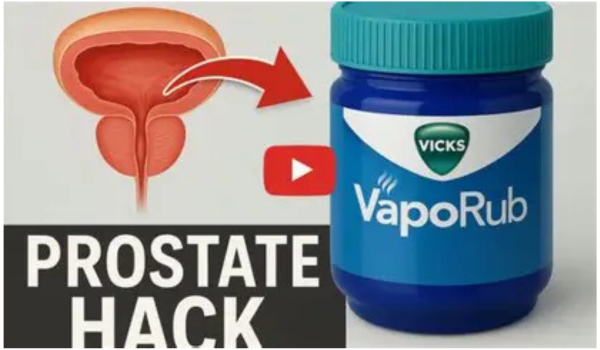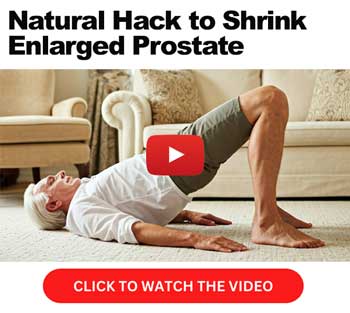Vicks VapoRub for Prostate Health: Myth or Real Remedy?
In the digital age, the internet brims with unconventional health remedies—some harmless, others downright implausible. One such widely circulated home remedy is using Vicks VapoRub—a mentholated chest rub—as a solution for prostate issues.
VICKS VAPORUB FOR PROSTATE HEALTH | Supporting Prostate Health Naturally at Home [2025]
From online forums and anecdotal blogs to countless viral TikTok videos, many claim that topical application of VapoRub near the groin or abdomen can alleviate prostatitis, benign prostatic hyperplasia (BPH), or improve urinary flow.
But does any scientific basis support this trend? Could camphor, menthol, eucalyptus, or other Vicks ingredients genuinely influence prostate anatomy or function?
This comprehensive blog dives deep into the evidence (or lack thereof), explores risks associated with off-label use, introduces effective prostate-health practices grounded in research, and guides readers toward safe, evidence-based strategies.
What Is Vicks VapoRub? Key Ingredients & Claims
Vicks VapoRub is an over-the-counter topical ointment traditionally used to ease coughs and chest congestion. It contains a blend of menthol (2.6–2.8%), camphor (4.7–5.25%), eucalyptus oil (~1.2–1.5%), plus inert ingredients such as petrolatum, cedarleaf oil, nutmeg oil, thymol, and turpentine oil.
How It’s Meant to Work?
- Menthol & Camphor: Provide cooling and analgesic sensations via skin application. These are recognized by the FDA as generally safe and effective for cough relief .
- Eucalyptus & Essential Oils: Offer aromatic benefits and may help unclog airways. Some essential oils exhibit antifungal properties—hence folk use for nail fungus .
In short, Vicks is meant for respiratory comfort and topical aches—not internal glandular function. Any variation from its labeled directions is considered off-label use, and claims regarding prostate use currently have no credible scientific backing.
The Rumor Mill: Why the Prostate?
The “Anti-Inflammatory” Misconception
Many believe Vicks’ menthol or eucalyptus content can reduce inflammation. However, skin-deep application does not translate to internal anti-inflammatory effects in a deep-seated organ like the prostate.
No pharmacokinetic evidence exists showing these compounds penetrate deeply or influence prostate tissue.
Easy Access & Strong Anecdotes
Vicks is affordable, familiar, and available. Social media users often share stories like:
“Applied Vicks on my lower abdomen before sleep, and next morning my urinary flow was stronger”—but these are anecdotes, not data.
A TikTok video titled “Understanding Prostate Health and Vicks Vaporub Use” may perpetuate ideas of benefits, but no data confirms its accuracy.
Misplaced Authority of Essential Oils
Essential oils are often trusted implicitly. Some individuals believe:
- Antimicrobial oils = better urinary health.
- Thymol oil (present in thyme) can treat skin fungus—but again, fungus ≠ prostate enlargement .
What Does the Science Say?
Lack of Evidence for Prostate Outcomes
- Peer-reviewed reviews on Vicks focus on respiratory care, skin use, nail fungus, and occasional misuse—but none address prostate health .
- A narrative review (“There’s the Rub”, 2025) examined benefits—like relief from cough and nail fungus—and complications like lipid pneumonia or camphor toxicity. No prostate health outcomes were included.
- Human trials exist only for cough and congestion (e.g., Eccles 2015, Paul 2010, Santhi 2017).
- Key takeaway: No scientific evidence supports using Vicks on or near the groin, abdomen, or perineum for prostate conditions.
Documented Risks of Off-Label Use
The narrative review flagged serious misuse side effects:
- Lipoid pneumonia and respiratory distress due to improper inhalation or application.
- Skin/ocular irritation—especially dangerous near sensitive areas .
- Camphor toxicity—seizures, organ damage with ingestion or excessive topical use .
Importantly, Vicks is not sterile nor intended for mucosal surfaces, and placing it near or on the genitals increases the risk of irritation, allergic reactions, infection, and systemic absorption—especially over thin adult skin or mucosa.
Scientifically Supported Practices for Prostate Health
If you’re concerned about prostate enlargement or prostatitis, these evidence-based strategies offer true potential benefits:
Lifestyle Changes & Self-Care
- Timed voiding & fluid management
- Avoid drinking 1–2 hours before bedtime to reduce nocturia.
- Urinate at first urge and try fully emptying the bladder.
- Diet optimized for prostate health
- Emphasize fruits, vegetables, healthy fats (avocado, salmon), and plant-based foods. These support overall prostate function.
- Pelvic floor exercises (Kegels)
- Improve control and urinary flow, beneficial for both men and women facing LUTS (lower urinary tract symptoms).
- Heat & cold therapies
- Sitz baths (alternating warm and cool water) can ease prostate-related discomfort.
Supplements with Some Clinical Backbone
- Saw palmetto (Serenoa repens)
- Widely studied for BPH. Mixed results: some benefits, though not a one-size-fits-all solution. Earlier costs on PSA interference may be unfounded .
- Stinging nettle root
- Demonstrated improvements in urinary flow and reduced prostate volume in trials.
- Beta-sitosterol, pygeum, rye pollen extract
- These supplements also show mild symptom relief in some clinical studies (though not mentioned in our current web search, they are supported elsewhere).
Medical Evaluations & Interventions
- Watchful waiting
- Regular monitoring may be sufficient for mild symptoms.
- Pharmaceutical options
- Alpha blockers (e.g., tamsulosin), 5‑alpha reductase inhibitors can reduce prostate size and symptom severity.
- Minimally invasive procedures
- Techniques like Aquablation, focal cryotherapy, and Prostate Artery Embolization (PAE) are available, especially when medication isn’t enough.
Why Vicks Doesn’t (and Won’t) Work for the Prostate
Target Accessibility
The prostate is deep beneath multiple tissue layers. Vicks is formulated for skin and respiratory relief, not to cross these barriers or reach glandular tissue.
Biological Mechanism Mismatch
Cooling menthol and camphorfenreceptors (TRPM8) cause subjective sensations—not physiological changes to the prostate. No mechanism exists to demonstrate anti‑inflammatory or hormonal effects within prostate tissue.
Misleading Analogies from Other Uses
Brochures tout Vicks’ antifungal effects on nails, but these require direct contact and long-term use, not a proxy for prostate therapy. Even then, evidence is limited and not transferable.
Potential Dangers of Off-Label Application Near Prostate
- Allergic dermatitis
- Contact dermatitis cases following application on genital skin have been reported—leading to itching, rash, swelling, and blistering .
- Infection risk
- Petrolatum-based products can trap heat and moisture, creating a breeding ground for bacteria and fungi—especially in warm, moist areas such as the groin.
- Systemic absorption & toxicity
- Thymol, camphor, and menthol can cross skin barriers—potentially reaching systemic circulation and causing unwanted side effects, especially with frequent or extensive use .
- Irritation to mucous membranes
- Mucosal surfaces are much more sensitive; even branded warnings advise avoiding eyes, nostrils, and genitalia.
- Delay in seeking proper care
- Minimizing symptoms with a placebo remedy may defer clinical evaluation and lead to progression of serious conditions like BPH, prostatitis, urinary retention, or cancer.
Practical, Safe Alternatives for Prostate Wellness
Symptom Management
- Warm sitz baths
- Safe and effective for soothing prostate-related discomfort.
- Kegel exercises
- Improve bladder control and help manage mild LUTS .
- Over-the-counter alpha‑adrenergic agents
- Medications like tamsulosin support gentle bladder muscle relaxation.
Supplements to Explore (Discuss with a Doctor)
| Supplement | Evidence Strength | Notes |
| Saw palmetto | Moderate | Potential symptom relief; mixed clinical results. |
| Nettle root | Promising | Some trials show decreased volume and improved flow . |
| Beta-sitosterol | Moderate | Improves urinary symptoms, not widely mentioned in web search. |
| Pygeum / Rye pollen | Moderate | Some evidence but variable quality. |
| Fish oil, lycopene | Limited | Safe to incorporate via diet. |
Lifestyle Changes
- Hydration timing
- Avoid fluids close to bedtime.
- Bladder habits
- Go when needed; avoid holding urine.
- Dietary patterns
- Emphasize vegetables, lean proteins, healthy fats.
- Stay active
- Regular exercise improves circulation and helps overall urinary function.
- Scheduled medical check-ups
- Regular PSA testing and digital rectal exams for men 50+, or 40+ with risk factors.
When to Seek Professional Help
See a urologist or primary care physician if you experience:
- Persistent weak or interrupted urinary flow
- Feeling of incomplete bladder emptying
- Blood in urine or semen
- Persistent pelvic/lower back pain not relieved by sitz baths
- PSA elevation or sudden unexplained urinary retention
Early diagnosis—whether it’s BPH, prostatitis, or prostate cancer—provides significantly better results from treatment.
Key Takeaways
- No credible evidence supports Vicks VapoRub for prostate health.
- Off-label use can cause skin issues, infection, and systemic exposure.
- Effective approaches are grounded in lifestyle modifications, pelvic health exercises, supplements with limited evidence, and—if needed—medical or minimally invasive intervention.
- Prioritize safety, evidence, and transparency over anecdotal remedies.
Conclusion
The viral allure of using Vicks VapoRub for prostate wellness is understandable—it’s accessible, familiar, and often featured in trusted home-recipe circles.
However, scientific scrutiny reveals this remedy is a placeholder for placebo, with no legitimate pathway to prostate improvement. Meanwhile, evidence-based methods—diet, exercise, pelvic health, supplements, and clinical care—carry real potential and minimal risk when used appropriately.
At SportAndMedicalSciences.org, we support curiosity and exploration—but we also champion truth, safety, and informed decisions. When it comes to prostate health, trust medical evidence—not internet hearsay.
References
- https://www.ncbi.nlm.nih.gov/pmc/articles/PMC11874951
- https://en.wikipedia.org/wiki/Vicks_VapoRub
- https://pubmed.ncbi.nlm.nih.gov/25382871
- https://pubmed.ncbi.nlm.nih.gov/20042525
- https://journals.sagepub.com/doi/full/10.1177/0009922817705185
.




